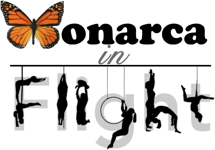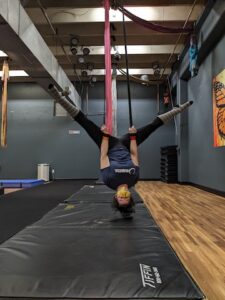Did you say trap or strap? BOTH!
Did you say trap or strap? BOTH!
(How two very different apparatus(es)* intersect)
At first glance static trapeze and aerial straps don’t have much on common: hard v. vertical; static v. single-point; hands-free choreography v. um, the total opposite.
But there are certain fundamental skills that not only are vital to one’s practice, but can transfer and improve across both. Today we’re going to talk about meathooks (but mostly about holding your inverted straddle).
A meathook is an inverted pike over one arm, a fundamental circus skill that is the foundation for not only any number of tricks, but is worth developing both for safety (you’d be amazed how having a stable meathook can back you up when exploring) and also a good check in on your body and where there are strengths and deficits that you can use to guide your practice.
The basic entry point for a meathook is from your inverted straddle. Here is where straps can help you toward your meathook on trapeze. For a lot of folks, finding the good stacked position (hips and shoulders in line with the bar and rigging) is hard on static trapeze, for all sorts of different reasons. Sometimes it’s because an aerialist’s body shape (what I like to call ‘topography’) means that the hands must be wide in order for the chest to remain stacked. Sometimes, the lack of straddle pike flexibility (pancake) means that the legs are hitting the bar in a way that makes it hard to maintain connection with your wrists. Sometimes you have amazing, powerful wonderful arms that happen to be shorter than your torso! Straps, by taking the bar out of the equation, gives you plenty of space to find your stacked position and let your straddle fly free. Because each arm is moving on an independent swivel, you can also really focus on your external shoulder rotation, which helps to build the muscle memory of that position when you take it back to trapeze, where the bar will not move.
Start in a froggy/spider straddle. You can tag against the straps to help you push your hips nice and high. Make sure your shoulders are in external rotation and your neck is long. This helps keep the hold out of your pecs and upper traps and helps find the stacked position. Look straight ahead with a neutral neck.
Extend one leg at a time. Keep your legs long and strong! If your pancake straddle tends towards passive compression or you find yourself with microbends when you go to your widest, scale them back! The important thing is staying stacked and engaged through your core and your legs. That may mean creating more of a star shape in your straddle while you build the connection in your shoulders and core.
Remember, before you can really work your meathook, you need to be strong and stable in your inverted straddle. By removing the barrier of a bar, straps** can inform your hard apparatus practice while strengthening those shoulders!
Thanks for making it this far. Next time – Skin-the-cats!
*Fun fact for the word nerds – either the collective “apparatus” or the English plural “apparatuses” can be considered ‘proper’ diction. “Apparati” is faux Latin but linguistically valid grammar (hey, ten years of studying classical languages might as well come in handy 😉).
**You could also work this drill using wrist locks in split fabric 😉
-Hannah Robinson



